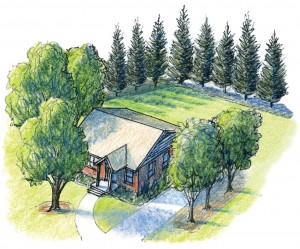Achieving comfort in a home involves more than just selecting stylish furnishings. It’s also about maintaining an ideal indoor temperature, controlling light levels, and reducing unwanted noise. Central to achieving this comfort are elements you may not immediately consider: your home’s windows, their Solar Heat Gain Coefficient (SHGC), the use of shading from trees and blinds, and the application of low-emissivity (Low-E) coatings on the windows.
The Role of Solar Heat Gain Coefficient
The Solar Heat Gain Coefficient is a key measure of a window’s ability to allow or block the sun’s heat. SHGC is the fraction of incident solar radiation admitted through a window and subsequently released as heat inside a home. It is expressed as a value between 0 and 1. A window with a higher SHGC allows more solar heat to pass through, while one with a lower SHGC blocks more solar heat.
Strategically selecting windows with appropriate SHGC values can significantly improve a home’s comfort and energy efficiency. For homes in cooler climates, windows with a higher SHGC can facilitate passive solar heating, reducing reliance on artificial heating. In contrast, in warmer climates, windows with a lower SHGC can prevent excessive heat gain, reducing the need for air conditioning.
The Power of Shading: Trees and Blinds
Beyond the windows themselves, shading plays a pivotal role in enhancing indoor comfort. Shading strategies can help control the amount of sunlight entering your home, mitigating glare, and reducing overheating during the warmer months.
Trees
Strategically planted trees can serve as natural sun blockers, providing significant shade during hot summer months while allowing sunlight through in winter when their leaves have fallen. Deciduous trees are particularly effective for this purpose. In addition to reducing heat gain, trees also add aesthetic appeal and can enhance property values.
Blinds
Blinds, both interior and exterior, can offer adjustable and versatile shading solutions. During periods of intense sunlight, blinds can be drawn to block heat and reduce glare. Conversely, on colder days or when sunlight is desirable, blinds can be opened to allow natural light and heat in. With a wide variety of styles and materials available, blinds can be selected to match any home decor and aesthetic preferences.
Low-E Coatings: Controlling Heat Transfer
Low-E coatings are microscopically thin layers of metallic oxides applied to window glazing surfaces. They are designed to minimize the amount of ultraviolet and infrared light that can pass through glass without compromising the amount of visible light that is transmitted.
Windows with Low-E coatings can play a significant role in enhancing home comfort. By reducing the U-factor of the window (the rate of heat transfer), these coatings help keep heat inside the house during winter and prevent heat gain during summer, thereby reducing energy consumption and maintaining a more stable indoor temperature.
Additionally, by blocking harmful ultraviolet light, Low-E coatings can protect furniture, flooring, and artwork from fading, while still allowing plenty of natural light to brighten your home.
Conclusion: Comfort through Smart Choices
Optimizing the comfort of your home involves a comprehensive approach that takes into account the specific features and orientation of your home, local climate conditions, and individual preferences. By understanding and utilizing the solar heat gain coefficient of windows, implementing strategic shading solutions, and applying Low-E coatings, you can enhance indoor comfort, reduce energy consumption, and make your home a more enjoyable place to live.
Embracing these techniques not only leads to more comfortable living spaces but also contributes to a more sustainable future. By reducing our reliance on artificial heating and cooling, we can decrease our carbon footprint and move towards a greener, more environmentally
